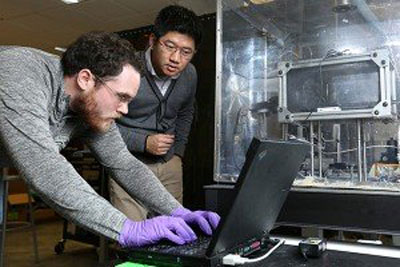| Posted: May 15, 2017 |
Laser printing with nanoparticles holds promise for medical research
(Nanowerk News) Electronic devices that can not only be implanted in the human body but also completely dissolve on their own – known as “bioresorbable” electronics – are envisioned by many as one of medical technology’s next frontiers. A new study by Missouri University of Science and Technology researchers suggests that a laser printing technique using nanoparticles could help unlock a more cost-effective approach to building sturdier and safer components.
|
|
Writing in the journal Advanced Materials ("Low-Cost Manufacturing of Bioresorbable Conductors by Evaporation–Condensation-Mediated Laser Printing and Sintering of Zn Nanoparticles"), the Missouri S&T researchers demonstrate a process to print tiny electronic components by using lasers to process print-ready zinc nanoparticles. The journal’s authors include Dr. Heng Pan, assistant professor of mechanical and aerospace engineering at Missouri S&T, and Dr. Xian Huang, a professor of biomedical engineering at Tianjin University in China and a former S&T faculty member.
|
 |
| Dr. Heng Pan, right, works in his lab with graduate student Brandon Ludwig, a co-author of a new research study on a low-cost process to manufacture bioresorbable electronics.
|
|
As Pan explains, bioresorbable electronics (also known as transient electronics) that use traditional microchip fabrication methods require costly optical patterning and vacuum deposition processes. Using laser printing is far more cost-effective – but potentially exposes zinc, magnesium and other necessary ingredients to oxygen, nitrogen and other ingredients that could cause adverse interactions.
|
|
The new process allows for zinc nanoparticles to be sintered together through an evaporation and condensation process that avoids surface oxides. The fabricated, oxide-free zinc conductors demonstrated high electrical conductivity, mechanical durability and water dissolvability, the researchers report.
|
|
“The new method can direct-print patterned zinc conductors on bioresorbable polymers with conductivity close to bulk values,” Pan says. “And the fabricated patterns on bioresorbable substrate can be readily integrated with high performance electronics.”
|
|
Pan’s research interests also include the field of stretchable electronics, which can be bended or folded to allow users to wear sensors on their clothing or directly on the skin.
|

